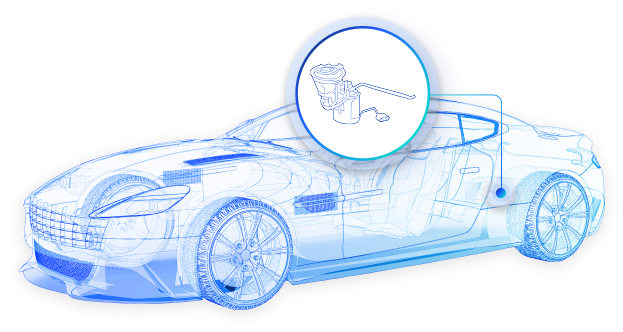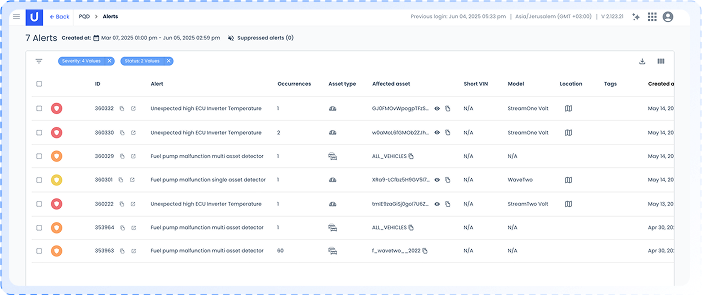

Avoiding Déjà Vu: How OEMs Can Stop Known Quality Failures From Resurfacing
This is the third blog in a spotlight series showcasing real-life case studies of OEMs who were able to utilize their connected vehicle data, powered by ML and AI to detect component failures earlier, reduce warranty costs, and improve customer satisfaction at scale.
Each case highlights how Upstream’s Proactive Quality Detection (PQD) solution helps OEMs to accelerate root-cause analysis (RCA), severity assessment, and prioritization of vehicle quality issues using AI-driven insights.
Read the first blog here.
Read the second blog here.
Fuel Pump Malfunction That Kept Coming Back
For an OEM operating in the APAC region, a known defect was proving more persistent than expected. The issue was tied to an inaccurate fuel temperature sensor embedded in the fuel pump assembly of a specific ICE model, impacting several production years.

Illustration: Fuel Pump (Source: Upstream)
Although the failure mode was understood and previously investigated, it continued to surface across the fleet, often without warning and sometimes long after the vehicle had been serviced. The sensor’s incorrect readings triggered faulty data inputs to the ECU, which in turn led to sudden reductions in engine power.
Drivers reported immediate performance loss and powertrain warning lights. Service centers flagged powertrain DTCs, but the recurring nature of the issue made it hard to separate new cases from old ones, leading to inconsistent handling, growing warranty costs, and customer frustration.
In cases like this, the problem isn’t a lack of understanding, it’s a lack of visibility. The OEM knew the cause: a faulty sensor. They knew the fix: replace the fuel pump assembly. But what they didn’t have was a reliable, scalable way to track recurrence across millions of vehicles in real time, or to pinpoint whether a failure was truly new or already resolved.
Given the architecture of the fuel delivery system, partial repairs were not an option. Affected vehicles required full fuel pump replacements. But with high service volumes and minimal differentiation between legacy and new faults, unnecessary replacements became a real risk, both financially and operationally.
PQD Enabled Real-Time Detection at Both the Asset and Fleet Level
To address this challenge, the OEM implemented two targeted detectors using Upstream’s PQD platform:
- The Single Asset Detector was trained to identify the specific fault signature tied to the fuel pump sensor defect. It analyzed the precise combination of DTCs, telemetry behavior, and temperature signals that preceded power loss events. This allowed the OEM to flag new incidents proactively, schedule service before drivability degradation occurred, and distinguish genuine recurrence from unrelated anomalies.
- The Group Monitoring Detector operated across the broader fleet. It surfaced clusters of similar failures in real time, identifying potential new production or supplier-related quality deviations as they emerged. This gave the OEM a strategic layer of protection, enabling early alerts on production trends or component reliability issues before they escalated into large-scale service campaigns.
Together, these detectors helped transform the OEM’s response model from reactive repair handling to proactive failure mode management.

Upstream’s Proactive Quality Detection Platform
The Outcome: Reduced Recurrence, Smarter Campaigns, Better Customer Experience
With PQD, the OEM could confidently manage a known issue without waiting for customer complaints or large claim volumes. They reduced service network strain, avoided unnecessary component replacements, and delivered faster, more targeted resolutions for impacted customers.
Most importantly, PQD provided a blueprint for scalable management of known failure modes, something increasingly critical in modern vehicle programs, where component integration makes diagnostics more difficult and repeat faults more expensive to resolve.
By tying each individual case back to telemetry and contextual data, the OEM protected its warranty budget, avoided potential safety incidents tied to power loss, and preserved brand confidence in markets where competition is fierce.
After-sales quality processes often focus on discovering new problems, but success also depends on how effectively known risks are contained. In this case, PQD didn’t uncover a mystery. It operationalized a solution, helping the OEM monitor, manage, and contain recurrence with precision.
As vehicle systems grow more complex and repair costs increase, the ability to track the known with the same rigor as the unknown is a critical pillar of modern automotive quality strategy.
Explore Upstream’s PQD platform to see how early quality issue detection and contextual analysis can support faster RCA, reduce warranty exposure, and improve customer satisfaction.

